[Now rewritten for the people outside my head to understand.]
This morning in the shower:Seriously considered: So I have this egg yolk wash that I put on challah (to make it shiny!) and on tart crusts (to keep them from getting soggy). I beat up a couple spare yolks with some water, and then I froze it, but when I thaw it, it's lumpy and gross.
In lab we freeze cells in glycerol (glycerine). And you can freeze proteins in sugar; they're not so happy if you stick them at -20C in just water (imagine raw hamburger, on a plate, after a week in the freezer. Not happy.).
Could I add 10% glycerol, or perhaps sugar, to delumpify/ extend the useful lifetime of my egg wash? Would I have to then dilute it with water to get it to brush onto crusts right? And does Sigma* sell food-grade glycerol? Alternatively, could I distill** the reagent-grade?***
(Answers: Yes, at 2%, and look at this, ewwwww, I had no idea; maybe; yes and it's kosher! but can be had much cheaper; yes but I totally don't have a high-vacuum line and heating mantle at home, though my dad did rescue a huge distillation coil from work...)
*A huge chemical company. They sell everything.
**Just like doing ethanol. Except imagine it's something like honey to start with. Turns out that's hard.
***Reagent-grade: Containing 1-5% of Other Junk. Don't worry. I wouldn't put reagent-grade chemicals in my mouth even if I did repurify them; one never knows quite what that last 1% was. Except... once when I ran out of sugar for my coffee.
Tuesday, January 30, 2007
Monday, January 29, 2007
Ask a Scientist: Antidepressants and Pregnancy (Intro, 1,2)
By request, and most especially for S and B, I am supplying a short and detailed, but not comprehensive, review of some common antidepressants and pregnancy.
Most doctors do not wish to prescribe any drugs for use in pregnancy; many doctors recommend that even Sudafed not be used- just in case!- even though there is an enormous amount of evidence that demonstrates no danger. For all my friends who wish to have adequate documentation with which to beat their doctors over the head, here you go.
This will be a series on Mondays and Thursdays.
For references relating to other drugs, more info, or PDFs, email me.
Series: Antidepressants, Pregnancy, Risks
[Disclaimer: I am not a medical professional; this is an academic summary of the evidence available and not a medical opinion. I do not offer medical advice. If you require medical opinions or treatment, please consult your physician.]
This information is drawn from published articles in medical journals, some of which are compiled here, and from public databases. (See also: summaries on Motherisk, FDA registries for pregnant women, this excellent Medscape article, and the FDA's index by drug name.) Information is also available through PubMed by searching various terms; I suggest starting with 'antidepressants and pregnancy'.
A list of generic and trade names is here.
****
Introduction
Despite the FDA's quite reasonable official stance that the risk/reward should be weighed individually, this attitude seems to be slow to catch on.
The FDA labels pregnancy drugs into five categories: A, B, C, D and X.
The risks discussed arose through incident reporting, animal studies, cohort studies (comparing two more-or-less matched groups), long-term drug tracking by manufacturers (including pregnancy registries), and various medical studies. You will notice, if you read the individual papers, that there is a large amount of variability between studies; human populations are heterogeneous. The smaller or more biased (nonrandom) a sample, the more variation one will expect from study to study.
Relatively few drugs are Class A; even, say, sertraline, which is a relatively old and well-studied AD, is Class C. So is Sudafed. So is Benadryl. This is because it is difficult to demonstrate NO risk, and because many drugs have some small risk associated. A patient might think Class C is a terrible risk in pregnancy, or that there are no studies in humans, but actually there are a lot of studies in pregnant humans. Yet the FDA says there are "no adequate and well-controlled studies in pregnant women" in the drug labelling. In fact, the AAFP says that Benadryl and Sudafed are safe in pregnancy. Overall, the FDA system is confusing, inaccurate, and not very informative; the patient should look up each drug herself to get good information. (The FDA decided in 1997 to replace the A-X categorization with narrative. Aaaaand... not yet.)
After reading a lot of papers, I'd say that the data indicate that many antidepressants are NOT harmful during pregnancy, and patients with depression are better advised to continue treatment. I believe the small risk is worth the benefits. Many doctors will say 'But we don't know what all the risks could be, so it's better not to risk at all, and any risk is too much for your little embryo.' I could not disagree more. We do know what the risks could be: that's why we do studies. Each woman should be able to decide for herself what risk, including small risks, are acceptable to her.
It is always possible, of course, that there are risks these studies have not picked up. The studies could be:
I have a personal interest: depression runs in my family, and SSRIs are my new best friend. But aside from that, I believe in the informative power of research and reject the 'what if... you can't prove a negative' attitude.
****
1. Spontaneous abortion: Risk may increase a little.
For reference, the spontaneous abortion (SA), or miscarriage, rate is reported as around 10% of all confirmed pregnancies. SA rates in these studies vary widely.
A study on 136 women who took bupropion in the first trimester reports that SA incidence increased to 14.7% vs. 4.5%. Tricyclics are reported to have no effect on SA in one study of 689 women; a meta-analysis (an overview of many unrelated studies) finds an overall SA increase to 12.3% from 10% for tricyclics.

The same meta-analysis reports SSRIs raise SA from 8.4% to 12.8%. The authors note that they cannot rule out depression as a contributing factor to SA.
Another single-cohort study cites SAs at 12% for venlafaxine vs. 7% basal, and 10.7% in other SSRIs. These groups are not significantly different from each other.
CONCLUSION: SSRIs, tricyclics, bupropion, and other antidepressants (ADs) may somewhat increase the rate of spontaneous abortion in early pregnancy. Basal SA rate is generally 10% of confirmed pregnancies, though sometimes reported lower among small cohorts. Antidepressant SA risk is apparently raised to 10-15%. This increase may or may not be significant (i.e., real), and is small.
2. Premature Birth: ADs either do or don't increase preterm birth.
There are at least two good, large studies on preterm birth and AD use. The first uses a Swedish birth database which includes 997 mothers who took ADs, out of >500,000 women total. In the general population, 5% of babies are born before 37 weeks; in all AD-medicated mothers it is 10%, and 10% in SSRI users. The second study follows 1,782 mothers who took SSRIs, 360 throughout pregnancy and >1000 with 1st trimester purchases. They find no increase at all in preterm birth and no decrease in birth rate.
CONCLUSION: There is not a lot of data on preterm births. These studies are both large population-based studies, but are not random except in the sense of including all of a registry. It is not possible to say whether preterm births are truly increased by AD usage in pregnancy. It may be slightly increased; one study shows a small effect.
Most doctors do not wish to prescribe any drugs for use in pregnancy; many doctors recommend that even Sudafed not be used- just in case!- even though there is an enormous amount of evidence that demonstrates no danger. For all my friends who wish to have adequate documentation with which to beat their doctors over the head, here you go.
This will be a series on Mondays and Thursdays.
For references relating to other drugs, more info, or PDFs, email me.
Series: Antidepressants, Pregnancy, Risks
- Introduction
- Spontaneous abortion
- Premature birth
- Congenital or teratogenic defects; that is, malformations in utero
- Cardiac defects
- Antenatal adaptation problems
- Muscle stiffness
- Breathing distress at birth
- Neurological withdrawal symptoms
- Breastfeeding risks
- Infant weight gain
- Long-term neurologic development
- Maternal risks of going without treatment
- Relapses
- Infant failure to thrive
- Parenting problems, attachment, child behavior
[Disclaimer: I am not a medical professional; this is an academic summary of the evidence available and not a medical opinion. I do not offer medical advice. If you require medical opinions or treatment, please consult your physician.]
This information is drawn from published articles in medical journals, some of which are compiled here, and from public databases. (See also: summaries on Motherisk, FDA registries for pregnant women, this excellent Medscape article, and the FDA's index by drug name.) Information is also available through PubMed by searching various terms; I suggest starting with 'antidepressants and pregnancy'.
A list of generic and trade names is here.
****
Introduction
Despite the FDA's quite reasonable official stance that the risk/reward should be weighed individually, this attitude seems to be slow to catch on.
The FDA labels pregnancy drugs into five categories: A, B, C, D and X.
| Category | Description |
|---|---|
| A | Adequate, well-controlled studies in pregnant women have not shown an increased risk of fetal abnormalities. |
B | Animal studies have revealed no evidence of harm to the fetus, however, there are no adequate and well-controlled studies in pregnant women. or Animal studies have shown an adverse effect, but adequate and well-controlled studies in pregnant women have failed to demonstrate a risk to the fetus. |
C | Animal studies have shown an adverse effect and there are no adequate and well-controlled studies in pregnant women. or No animal studies have been conducted and there are no adequate and well-controlled studies in pregnant women. |
| D | Studies, adequate well-controlled or observational, in pregnant women have demonstrated a risk to the fetus. However, the benefits of therapy may outweigh the potential risk. |
| X | Studies, adequate well-controlled or observational, in animals or pregnant women have demonstrated positive evidence of fetal abnormalities. The use of the product is contraindicated in women who are or may become pregnant. |
The risks discussed arose through incident reporting, animal studies, cohort studies (comparing two more-or-less matched groups), long-term drug tracking by manufacturers (including pregnancy registries), and various medical studies. You will notice, if you read the individual papers, that there is a large amount of variability between studies; human populations are heterogeneous. The smaller or more biased (nonrandom) a sample, the more variation one will expect from study to study.
Relatively few drugs are Class A; even, say, sertraline, which is a relatively old and well-studied AD, is Class C. So is Sudafed. So is Benadryl. This is because it is difficult to demonstrate NO risk, and because many drugs have some small risk associated. A patient might think Class C is a terrible risk in pregnancy, or that there are no studies in humans, but actually there are a lot of studies in pregnant humans. Yet the FDA says there are "no adequate and well-controlled studies in pregnant women" in the drug labelling. In fact, the AAFP says that Benadryl and Sudafed are safe in pregnancy. Overall, the FDA system is confusing, inaccurate, and not very informative; the patient should look up each drug herself to get good information. (The FDA decided in 1997 to replace the A-X categorization with narrative. Aaaaand... not yet.)
After reading a lot of papers, I'd say that the data indicate that many antidepressants are NOT harmful during pregnancy, and patients with depression are better advised to continue treatment. I believe the small risk is worth the benefits. Many doctors will say 'But we don't know what all the risks could be, so it's better not to risk at all, and any risk is too much for your little embryo.' I could not disagree more. We do know what the risks could be: that's why we do studies. Each woman should be able to decide for herself what risk, including small risks, are acceptable to her.
It is always possible, of course, that there are risks these studies have not picked up. The studies could be:
- Deliberately biased, by influence from drug companies. I find this unlikely because different studies mainly get similar results.
- Looking for the wrong things. Many studies, however, look for all neurological symptoms or all congenital defects. Previous animal studies have given researchers some idea of what to look for; however, animal models are not perfect models for human disease.
- Using a biased sample. This is possible, although many studies look at thousands of patients. But are they representative of the population? Are affluent white women more likely to take SSRIs? Are there genetic factors in other ethnic groups? (The African-American ethnic group, for example, is known to have a polymorphism that can reduce cardiac drug efficacy.)
- Not picking up some rare conditions because the numbers are too low. This is possible as well; however, if it is the case, it may be either not above background (the naturally occurring level of X) in a reasonable number of patients, and/or it's so rare that it is probably not a major concern.
- Anything else I haven't thought of.
I have a personal interest: depression runs in my family, and SSRIs are my new best friend. But aside from that, I believe in the informative power of research and reject the 'what if... you can't prove a negative' attitude.
****
1. Spontaneous abortion: Risk may increase a little.
For reference, the spontaneous abortion (SA), or miscarriage, rate is reported as around 10% of all confirmed pregnancies. SA rates in these studies vary widely.
A study on 136 women who took bupropion in the first trimester reports that SA incidence increased to 14.7% vs. 4.5%. Tricyclics are reported to have no effect on SA in one study of 689 women; a meta-analysis (an overview of many unrelated studies) finds an overall SA increase to 12.3% from 10% for tricyclics.

The same meta-analysis reports SSRIs raise SA from 8.4% to 12.8%. The authors note that they cannot rule out depression as a contributing factor to SA.
Another single-cohort study cites SAs at 12% for venlafaxine vs. 7% basal, and 10.7% in other SSRIs. These groups are not significantly different from each other.
CONCLUSION: SSRIs, tricyclics, bupropion, and other antidepressants (ADs) may somewhat increase the rate of spontaneous abortion in early pregnancy. Basal SA rate is generally 10% of confirmed pregnancies, though sometimes reported lower among small cohorts. Antidepressant SA risk is apparently raised to 10-15%. This increase may or may not be significant (i.e., real), and is small.
2. Premature Birth: ADs either do or don't increase preterm birth.
There are at least two good, large studies on preterm birth and AD use. The first uses a Swedish birth database which includes 997 mothers who took ADs, out of >500,000 women total. In the general population, 5% of babies are born before 37 weeks; in all AD-medicated mothers it is 10%, and 10% in SSRI users. The second study follows 1,782 mothers who took SSRIs, 360 throughout pregnancy and >1000 with 1st trimester purchases. They find no increase at all in preterm birth and no decrease in birth rate.
CONCLUSION: There is not a lot of data on preterm births. These studies are both large population-based studies, but are not random except in the sense of including all of a registry. It is not possible to say whether preterm births are truly increased by AD usage in pregnancy. It may be slightly increased; one study shows a small effect.
Friday, January 26, 2007
Friday Library: A Week In Pictures
Dear Readers,
My snarkiness can find no appropriate science text at present. Therefore, I break with tradition and present you with pictures-and-narrative. Next week, we return to our regularly scheduled Dead Professor Books.
It was cold.
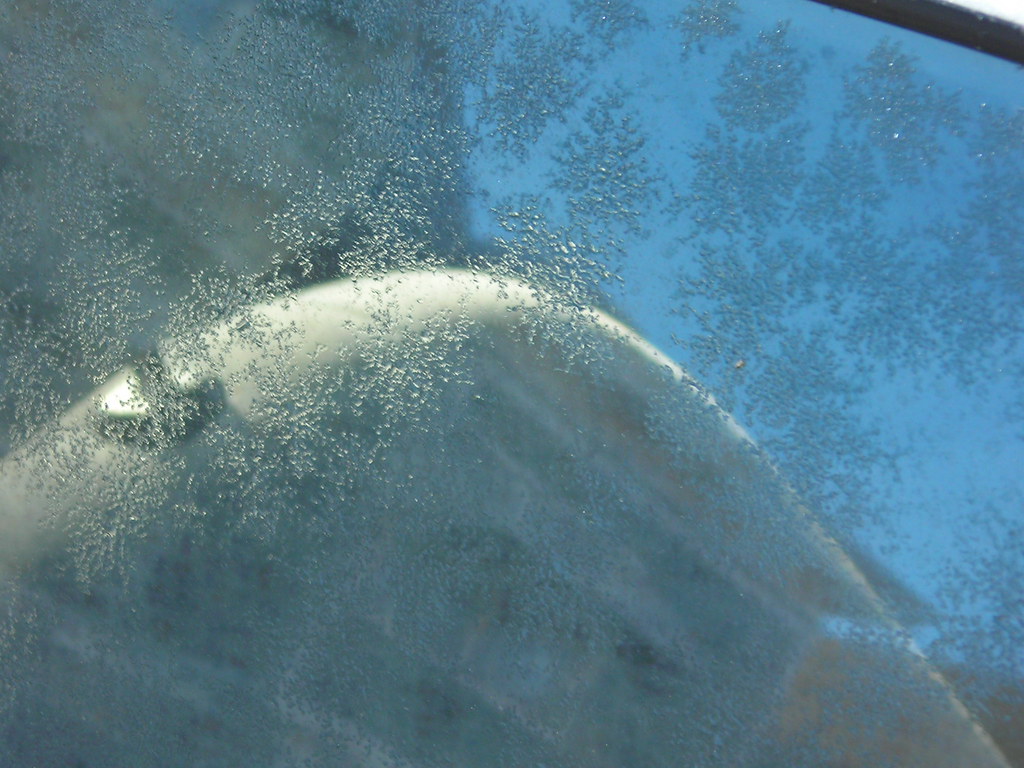
So I took a rather enormous amount of grains and seeds-
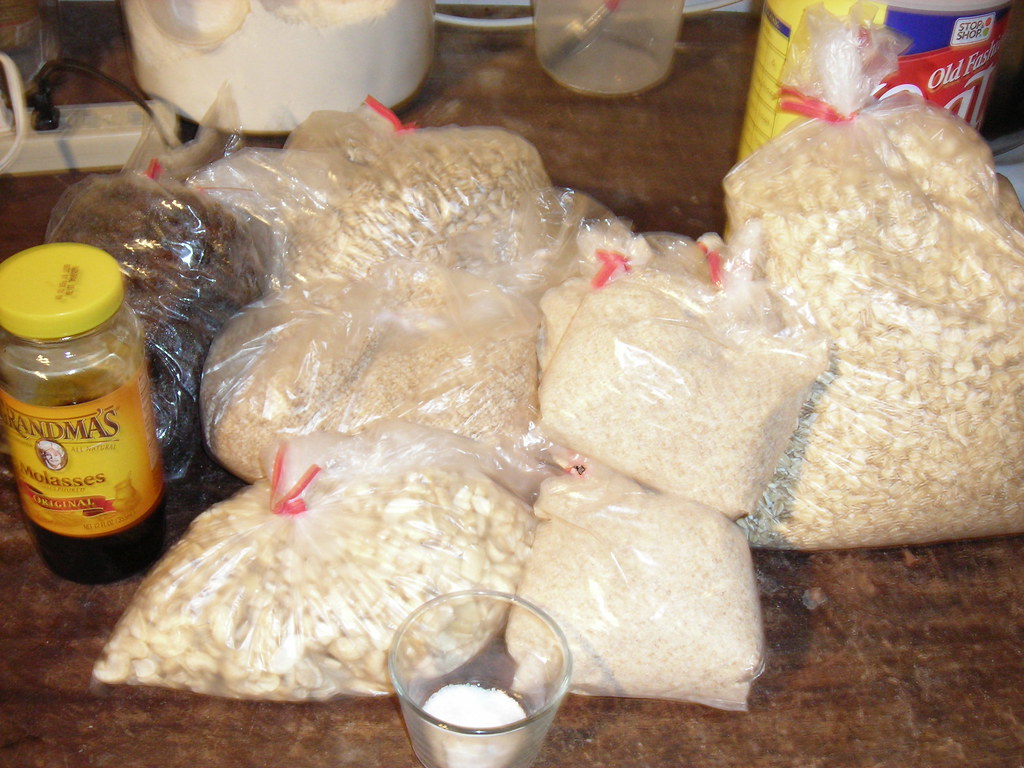
-and turned them into Spousal-Weight-Sustaining Granola. Rather a lot.
Note to self: 2 pounds sunflower seeds = overkill.
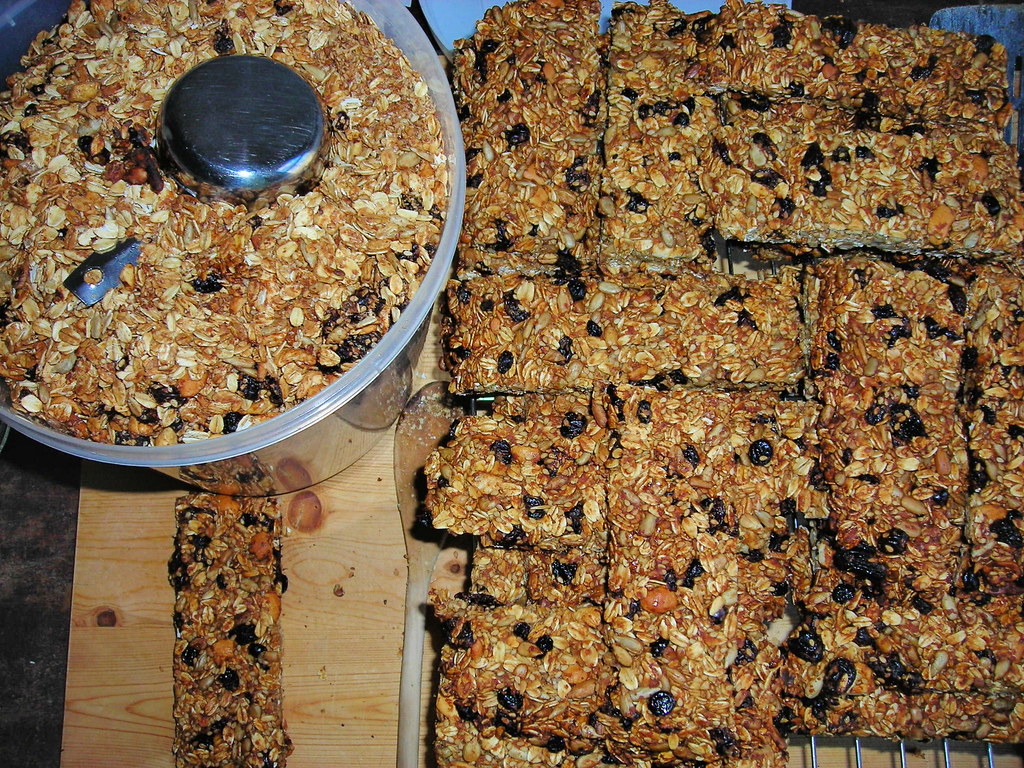
I looked at some plants.
This quince wished it had stayed dormant.


And the spruce is none too happy either.
This is much prettier now that the wasps are gone.
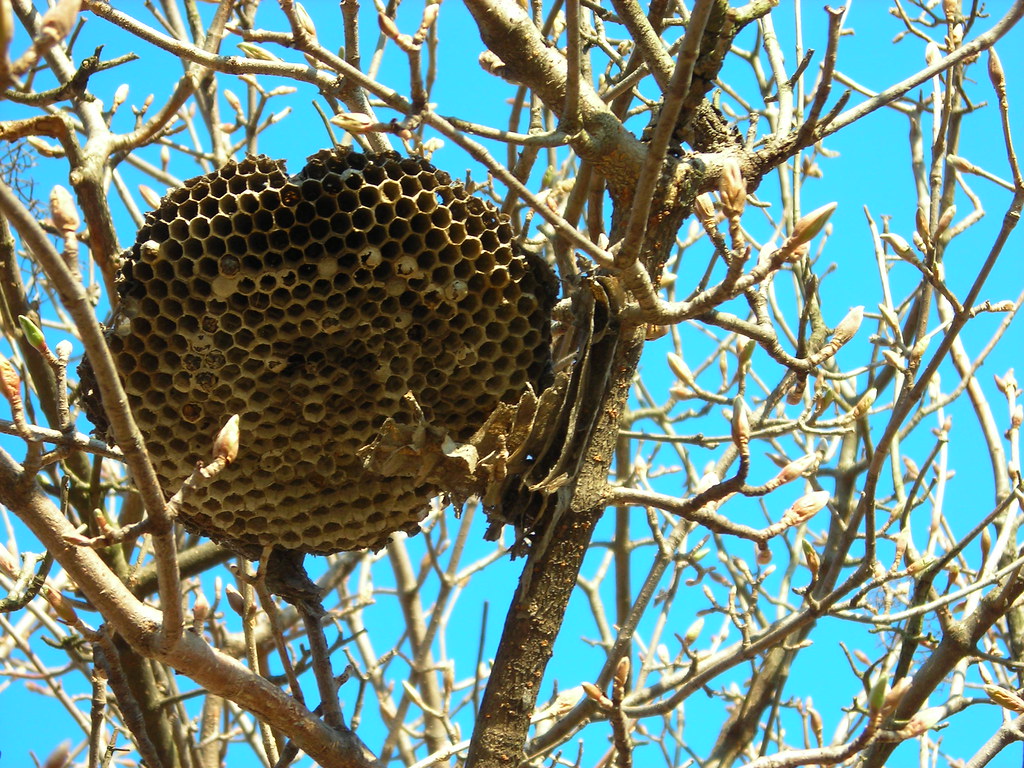
I saw some buildings.



Eventually I had to stop taking pictures and go to work.
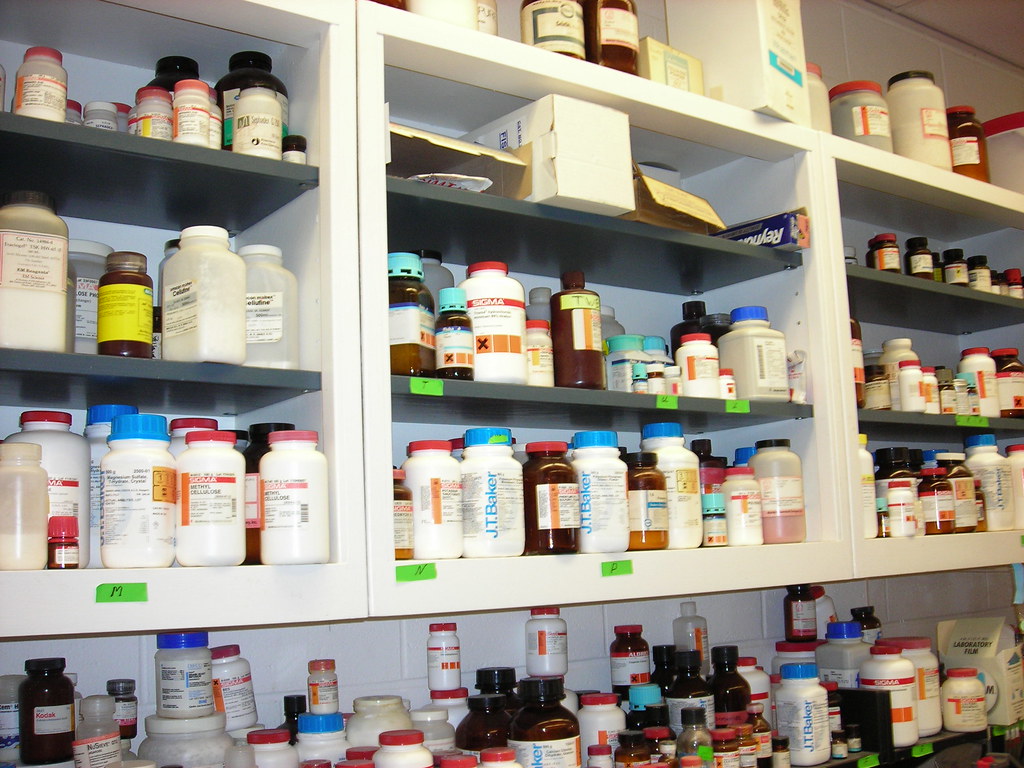
This is where equipment goes to die.
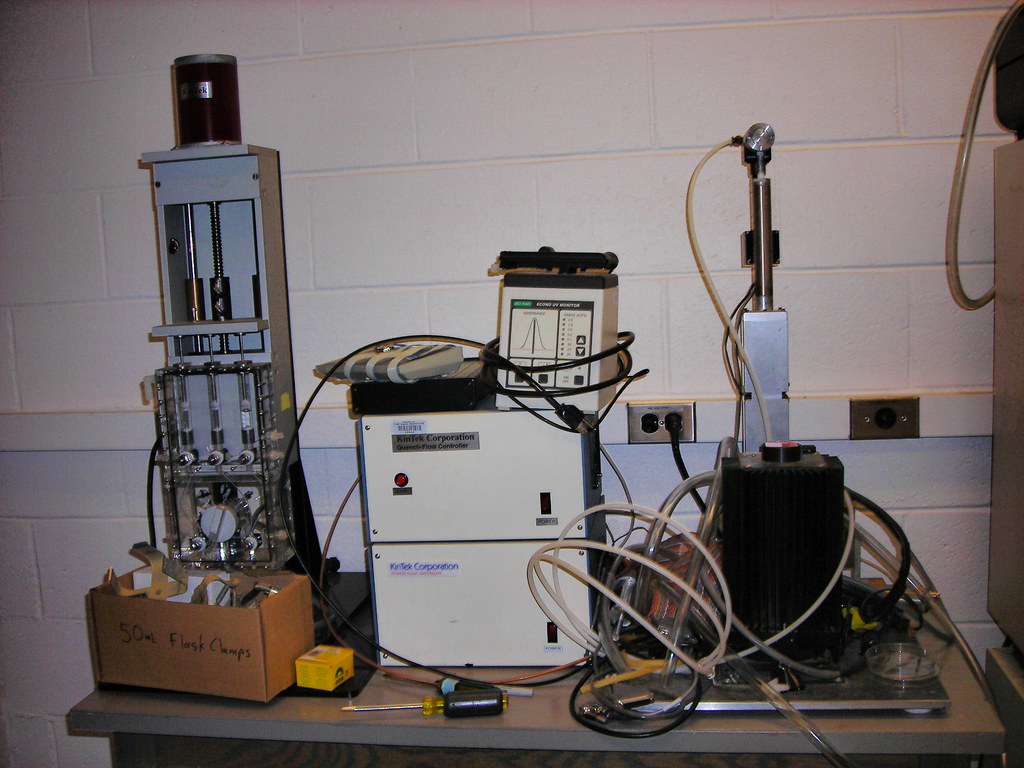
Our dishwasher is on semi-strike because she hates us.
And we can't fire her. Ah, unions.
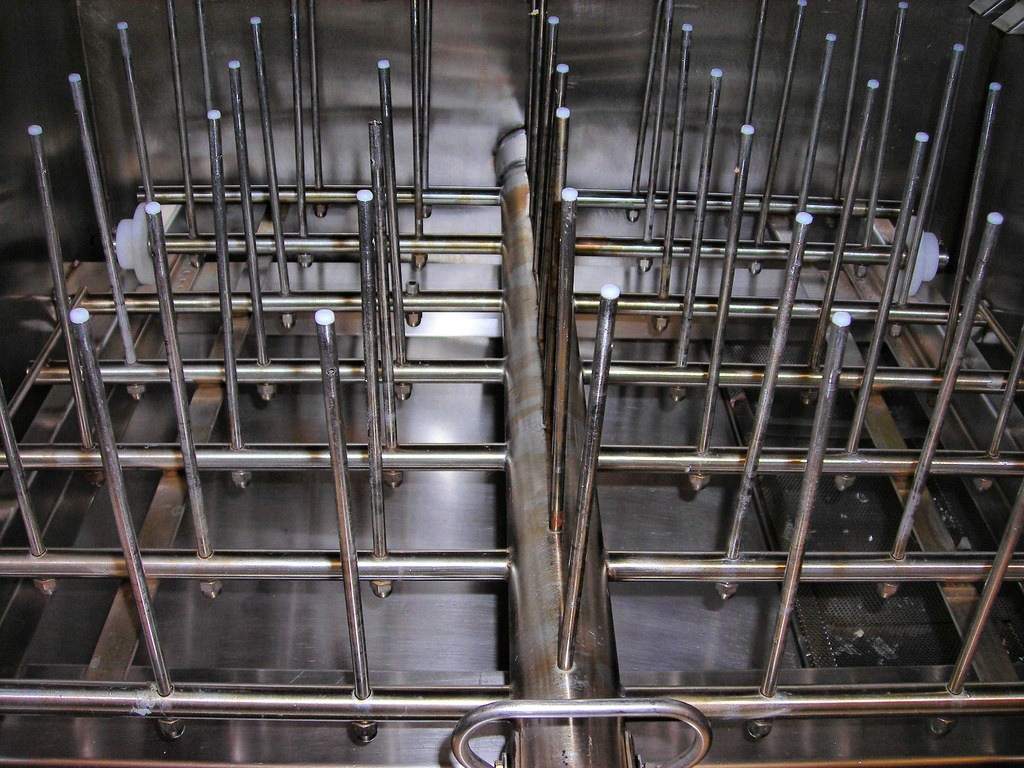
This one's for Juliane. ;)
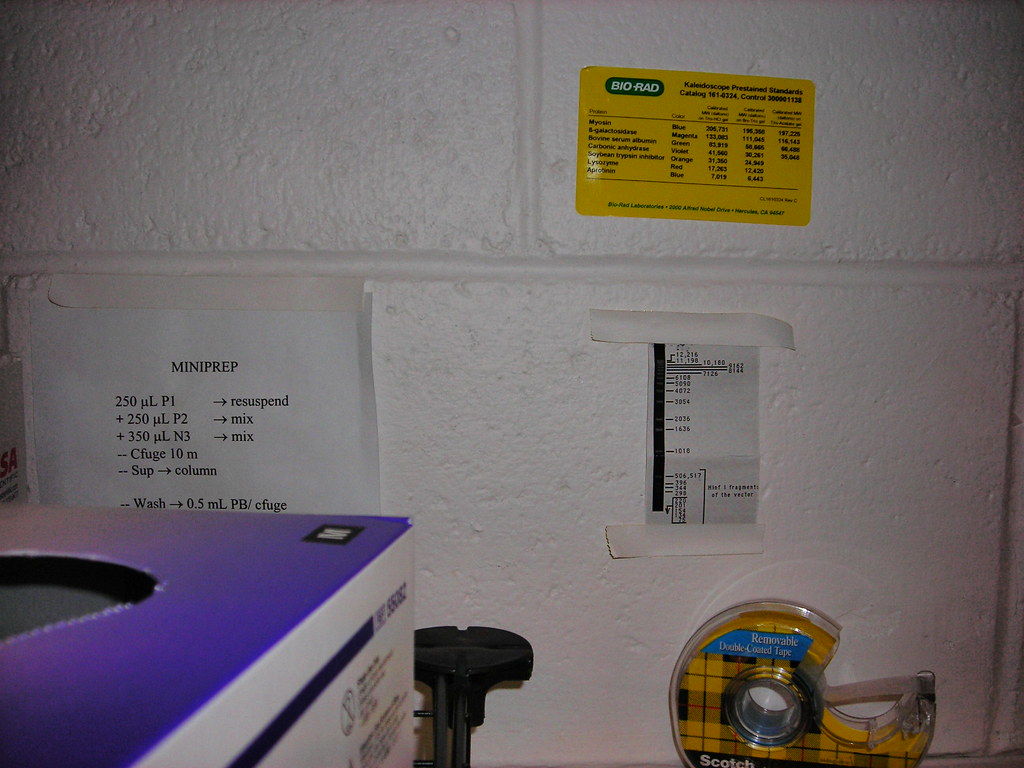
But enough of lab; my experiments hate me. So I went home and
dumped all my fabric on the floor:

So that, in a fit of mania, I could compulsively sort and label it all.
Again, Mr. S was frightened.

I took a long walk specifically to bring you this picture:

Yes, they certainly do.
And then finally this week was over. Good night.
Here's hoping the next one's better.

My snarkiness can find no appropriate science text at present. Therefore, I break with tradition and present you with pictures-and-narrative. Next week, we return to our regularly scheduled Dead Professor Books.
It was cold.

So I took a rather enormous amount of grains and seeds-

-and turned them into Spousal-Weight-Sustaining Granola. Rather a lot.
Note to self: 2 pounds sunflower seeds = overkill.

I looked at some plants.
This quince wished it had stayed dormant.


And the spruce is none too happy either.
This is much prettier now that the wasps are gone.

I saw some buildings.



Eventually I had to stop taking pictures and go to work.

This is where equipment goes to die.

Our dishwasher is on semi-strike because she hates us.
And we can't fire her. Ah, unions.

This one's for Juliane. ;)

But enough of lab; my experiments hate me. So I went home and
dumped all my fabric on the floor:

So that, in a fit of mania, I could compulsively sort and label it all.
Again, Mr. S was frightened.

I took a long walk specifically to bring you this picture:

Yes, they certainly do.
And then finally this week was over. Good night.
Here's hoping the next one's better.

Thursday, January 25, 2007
Veronica, We Expected Better (Or: Scientists in the Media)
It's official: It is a Week Of Snark.
But first, early mornings at the S household:
-ATTACK CUDDLE!
-I prefer frontal assaults.
****
Dear Veronica Mars Writers,
Your show, it is entertaining. I am willing to overlook how our intrepid sleuth screams when attacked (couldn't she kick someone in the groin, for once?) and her amazing propensity for not telling anyone where she's gone.
However, your last episode, 'Show Me The Monkey' (har. har.) needed some serious work. To wit: your portrayal of lab sucked.
Consider:
A Socially Adjusted, Modest, Graceful, Interesting Scientist
P.S. Escaped large animals cause panic and government inquiries. Not: ordering another one.
But first, early mornings at the S household:
-ATTACK CUDDLE!
-I prefer frontal assaults.
****
Dear Veronica Mars Writers,
Your show, it is entertaining. I am willing to overlook how our intrepid sleuth screams when attacked (couldn't she kick someone in the groin, for once?) and her amazing propensity for not telling anyone where she's gone.
However, your last episode, 'Show Me The Monkey' (har. har.) needed some serious work. To wit: your portrayal of lab sucked.
Consider:
- Nobody stores their monkeys in the lab. This is what animal facilities are FOR.
- Because to work with primates, or even be in a room with them, you need clearance, training, and a TB test. And then you have to swipe in.
- And besides, who wants to work with a monkey in the lab?
- Ditto on the rats. Ewwww.
- Also, the chick next door? Nobody covers their entire lab space with experimental plants and grow lights. They make greenhouses for that. Really.
- And while tea does live in lab, not so much next to the sink. Safety gets upset.
- Nobody wears their lab coat all the time.
- Much less into the school cafeteria.
- And they didn't have anything in their pockets. And the coats were all clean. Come on.
- And nobody's timer went off the whole episode.
- That researcher chick is way too uptight.
- Because a grad student's response to crash-and-burn is, Well, phooey; who's for a drink?
- And by the way do you have any idea how much a research monkey COSTS?
- Thousands of dollars. Like $5000 or $10,000. Each.
- Plus the $50 per day per monkey to house them.
- So you don't autopsy the damn monkey after you make it learn stuff.
- And by the way, scientists have lives.
A Socially Adjusted, Modest, Graceful, Interesting Scientist
P.S. Escaped large animals cause panic and government inquiries. Not: ordering another one.
Wednesday, January 24, 2007
Messages to the Aether
Or: The Whining Continues
Dear Self,
High stress makes the body fall apart. We down here in the stomach region do not appreciate your twitching. Chill out.
Dear Adored Spousal Unit,
The crockpot chicken that you made was very good; thank you. However, liquid expands when heated. Now the crockpot smells of fried chicken and fried plastic. If this were the first time, I would be more amused. It's not. I bought a new one. Kindly study elementary thermodynamics before using it.
Dear Hellacious State,
Decide: winter or spring? It's slushy. I don't like it. While you're at it, tell me why your drivers know neither Red Means Stop, Yes You, Right Now, nor One Way Streets Mean ONLY One Way, nor Don't Drive 40 On Ice, Moron, nor Yield to Pedestrian In The Fricking Crosswalk Already? Also, if you have a moment, do tell the police to round up a give-a-damn for my neighborhood. We pay our fireplacing taxes too. I've had it with dark streets, gunfire, and muggings. But don't worry, I won't bother you about the Mafia, the way our mayor's embezzling and taking kickbacks, or the gangs that come up from Even More Hellacious City. I've given up.
Dear Experiments,
Would you work twice? In a row? Please? I have made sacrifices and ablutions. I have remade all my solutions; I have scrubbed my tubes in soap, distilled water, ethanol, and MilliQ water. I have added a pinch of eye of newt. I have read through the last ten times I did you, and I have religiously reproduced every detail from the last time you were happy. I have danced beneath the sprinkler heads. I have worked odd hours and early mornings. Please do what you should. I am tired of repeating you, and it is late.
Sincerely yours,
Jenny Fireplacin' Scientist
Dear Self,
High stress makes the body fall apart. We down here in the stomach region do not appreciate your twitching. Chill out.
Dear Adored Spousal Unit,
The crockpot chicken that you made was very good; thank you. However, liquid expands when heated. Now the crockpot smells of fried chicken and fried plastic. If this were the first time, I would be more amused. It's not. I bought a new one. Kindly study elementary thermodynamics before using it.
Dear Hellacious State,
Decide: winter or spring? It's slushy. I don't like it. While you're at it, tell me why your drivers know neither Red Means Stop, Yes You, Right Now, nor One Way Streets Mean ONLY One Way, nor Don't Drive 40 On Ice, Moron, nor Yield to Pedestrian In The Fricking Crosswalk Already? Also, if you have a moment, do tell the police to round up a give-a-damn for my neighborhood. We pay our fireplacing taxes too. I've had it with dark streets, gunfire, and muggings. But don't worry, I won't bother you about the Mafia, the way our mayor's embezzling and taking kickbacks, or the gangs that come up from Even More Hellacious City. I've given up.
Dear Experiments,
Would you work twice? In a row? Please? I have made sacrifices and ablutions. I have remade all my solutions; I have scrubbed my tubes in soap, distilled water, ethanol, and MilliQ water. I have added a pinch of eye of newt. I have read through the last ten times I did you, and I have religiously reproduced every detail from the last time you were happy. I have danced beneath the sprinkler heads. I have worked odd hours and early mornings. Please do what you should. I am tired of repeating you, and it is late.
Sincerely yours,
Jenny Fireplacin' Scientist
Tuesday, January 23, 2007
The Mistress of the Lab Becomes Grumpy
In fact, today I am EXCEEDINGLY grumpy. Let me share.
The undergrads have returned to lab. They are inexperienced, loud, and in my way. They do not recognize their limits, and do not ask the right questions ('You do know that tube will implode if you run it more than half full?'; 'That's acrylamide. Put on gloves and go to the hood. NOW.'; 'AAAAH! No! Close the autoclave ALL THE WAY!').
3. The advisor persists in lauding the undergrads, who are all brilliant! Because they go to school here because Mommy and Daddy are rich! Because they memorize things! Even though they couldn't extrapolate to save their lives! We grad students, however, are total idiots, because we did not attend Snooty schools.
Mostly I am out of temper because I feel super extra lame: nothing I do works.
The undergrads irritate me because they have no humility, proportion, or work ethic, largely. They are continually told that they are the Smartest Bestest Ever. Particularly in lab, I think this impedes them learning useful things.
Humility is an important (and often absent) element of science research. If we already knew everything, we wouldn't be researching, would we now? Now that science, and especially biology, divides into specialized fiefdoms, there is usually no other Expert On X in the vicinity. This can breed certain unsavory attitudes of superiority, which are exacerbated by Snooty U-ness. My colleagues in particular tend to forget that the next person over knows just as much as them-- about something else.
And then, to make it better, my colleagues are like pirhanas. It's the 'stags in mating season' styles of scientific interaction; if you admit ignorance or error, they attack, and even if you don't, they play dominance games.
I detest this attitude. There's a big difference between not knowing something, not realizing you don't know it, and being unwilling to admit it. The latter two categories, I find, respectively, irritating and soulless. I try to maintain an attitude of proper humility: knowing I'm ignorant, I'm willing to learn, but not to be attacked. I've met a lot of scientists who think they already know everything, and are unwilling to learn. This is pride perpetuating ignorance and willful blindness. It can lead to very bad science: looking for the result you wish you'd gotten, or trying to prove your hypothesis, or throwing out data because it's not what you wanted, or just not thinking hard enough to do the proper controls.
This is why I loathe both my lab, and the undergrads. Oh, please, somebody let me out.
The undergrads have returned to lab. They are inexperienced, loud, and in my way. They do not recognize their limits, and do not ask the right questions ('You do know that tube will implode if you run it more than half full?'; 'That's acrylamide. Put on gloves and go to the hood. NOW.'; 'AAAAH! No! Close the autoclave ALL THE WAY!').
3. The advisor persists in lauding the undergrads, who are all brilliant! Because they go to school here because Mommy and Daddy are rich! Because they memorize things! Even though they couldn't extrapolate to save their lives! We grad students, however, are total idiots, because we did not attend Snooty schools.
Mostly I am out of temper because I feel super extra lame: nothing I do works.
The undergrads irritate me because they have no humility, proportion, or work ethic, largely. They are continually told that they are the Smartest Bestest Ever. Particularly in lab, I think this impedes them learning useful things.
Humility is an important (and often absent) element of science research. If we already knew everything, we wouldn't be researching, would we now? Now that science, and especially biology, divides into specialized fiefdoms, there is usually no other Expert On X in the vicinity. This can breed certain unsavory attitudes of superiority, which are exacerbated by Snooty U-ness. My colleagues in particular tend to forget that the next person over knows just as much as them-- about something else.
And then, to make it better, my colleagues are like pirhanas. It's the 'stags in mating season' styles of scientific interaction; if you admit ignorance or error, they attack, and even if you don't, they play dominance games.
I detest this attitude. There's a big difference between not knowing something, not realizing you don't know it, and being unwilling to admit it. The latter two categories, I find, respectively, irritating and soulless. I try to maintain an attitude of proper humility: knowing I'm ignorant, I'm willing to learn, but not to be attacked. I've met a lot of scientists who think they already know everything, and are unwilling to learn. This is pride perpetuating ignorance and willful blindness. It can lead to very bad science: looking for the result you wish you'd gotten, or trying to prove your hypothesis, or throwing out data because it's not what you wanted, or just not thinking hard enough to do the proper controls.
This is why I loathe both my lab, and the undergrads. Oh, please, somebody let me out.
Monday, January 22, 2007
In Which I Develop Digital Camera Syndrome
That is, a desire to take pictures of everything. So while I continue to research things (aah, my head), here's some stream-of-picture blogging.
It finally snowed.

I obsessively polished the kettle. Mr. S was frightened.
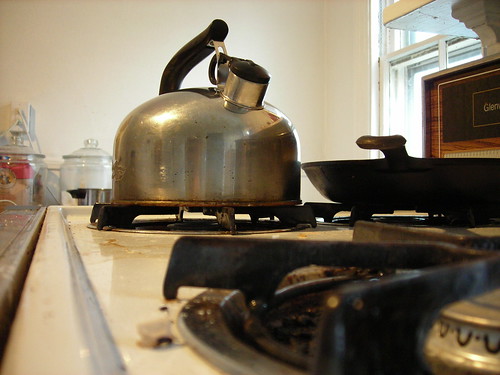
Then it got sunny.

I saw a peculiar vine.

I saw a bush.

And I noticed that the card catalog is quite attractive.

The End!
It finally snowed.

I obsessively polished the kettle. Mr. S was frightened.

Then it got sunny.

I saw a peculiar vine.

I saw a bush.

And I noticed that the card catalog is quite attractive.

The End!
Friday, January 19, 2007
Friday Library: Experimental Biology
Brought to you by the Dead Professors Book Heap.

Experimental Biology
Richard W. van Norman
Prentice-Hall, 1963
This detailed and dated work is a pompous treatise on Science, how to worship it, how the 'layman' should come to an elementary understanding of centrifuges in order to better himself [sic] and how the Scientist Is Always Right.
Above, a microtome: Some things never change.
****
The Compound Microscope


[Left: Old scope. "Fig. 8-2: A recent model, high-grade microscope." Right: The second-newest of my lab's six scopes. Bells, whistles, laser table, etc.]
To the conservative old timer, some of the newer models hardly look like microscopes. Figure 8-2 shows the Leitz Labolux IIIa. [Ed: now Leica.] The body tube contains a set of prisms arranged to form the image at the eyepiece, as in the conventional microscope. The prism system, however, permits the tilting of the eyepiece for greater comfort and even allows the upper part of the body tube to be rotated.
Selection of Techniques
Most of the modern experiments in biology employ instruments, tools, or techniques assembled from the various physical sciences.... Many papers in the literature contain descriptions of complicated assemblies of parts put together for use in rather simple experiments. If such an instrument (or combination of instruments) is unique and expensive, or if it depends on principles not commonly used, it is likely to be called 'elegant.'... Some people, who are born gadgeteers, do all their experimenting with such instruments. It is fun and stimulating to the imagination.
...
Not all experimental research requires elaborate instrumentation, however. Even the most impassioned gadgeteer, with pliers for hands and vacuum tubes for brains, would agree that the most completely mechanized work is not necessarily the most 'scientific.'
...
Selection and Preparation of Organisms
In addition to the strict scientific aspects of choosing the organism which will best answer the question, there is no harm in remembering the feelings of the general public. Experiments on animals are very necessary, but they may seem cruel to the layman [sic] who has had little experience or training and who does not understand experimental research... Occasionally a group of do-gooders becomes fanatical about the use of animals in research. Picturing the biological scientist as a cruel, inhumane monster without a conscience, they even apply pressure to legislative bodies urging the passage of laws which would in fact stifle medical research, but these same persons are as willing as anyone else to accept modern medicine's ability to keep them alive longer.... Actually, modern biologists have an appreciation of animal life that the fanatics can never achieve. They never condone needless cruelty. [Ed: But sometimes they design experiments badly, and the net effect is the same.]

Experimental Biology
Richard W. van Norman
Prentice-Hall, 1963
This detailed and dated work is a pompous treatise on Science, how to worship it, how the 'layman' should come to an elementary understanding of centrifuges in order to better himself [sic] and how the Scientist Is Always Right.
Above, a microtome: Some things never change.
****
The Compound Microscope


[Left: Old scope. "Fig. 8-2: A recent model, high-grade microscope." Right: The second-newest of my lab's six scopes. Bells, whistles, laser table, etc.]
To the conservative old timer, some of the newer models hardly look like microscopes. Figure 8-2 shows the Leitz Labolux IIIa. [Ed: now Leica.] The body tube contains a set of prisms arranged to form the image at the eyepiece, as in the conventional microscope. The prism system, however, permits the tilting of the eyepiece for greater comfort and even allows the upper part of the body tube to be rotated.
Selection of Techniques
Most of the modern experiments in biology employ instruments, tools, or techniques assembled from the various physical sciences.... Many papers in the literature contain descriptions of complicated assemblies of parts put together for use in rather simple experiments. If such an instrument (or combination of instruments) is unique and expensive, or if it depends on principles not commonly used, it is likely to be called 'elegant.'... Some people, who are born gadgeteers, do all their experimenting with such instruments. It is fun and stimulating to the imagination.
...
Not all experimental research requires elaborate instrumentation, however. Even the most impassioned gadgeteer, with pliers for hands and vacuum tubes for brains, would agree that the most completely mechanized work is not necessarily the most 'scientific.'
...
Selection and Preparation of Organisms
In addition to the strict scientific aspects of choosing the organism which will best answer the question, there is no harm in remembering the feelings of the general public. Experiments on animals are very necessary, but they may seem cruel to the layman [sic] who has had little experience or training and who does not understand experimental research... Occasionally a group of do-gooders becomes fanatical about the use of animals in research. Picturing the biological scientist as a cruel, inhumane monster without a conscience, they even apply pressure to legislative bodies urging the passage of laws which would in fact stifle medical research, but these same persons are as willing as anyone else to accept modern medicine's ability to keep them alive longer.... Actually, modern biologists have an appreciation of animal life that the fanatics can never achieve. They never condone needless cruelty. [Ed: But sometimes they design experiments badly, and the net effect is the same.]
Thursday, January 18, 2007
Nanna Reincarnates as a Sarcastic 16-year-old
My youngest sister, Prudence*, is in high school. She's also the French Maid in the school play and an EMT, and I couldn't be more proud of her. (Except for that morning last summer when she totaled the car and took out 40 feet of oak fence, a mailbox, and a flagpole. She was miraculously unscathed.) She inherited Nanna's personality: ornery.
P:Last night we got a call for a wreck on the interstate.
-Was it bad?
-It was a couch.
-????
-Dropped off a truck and someone mistook it for a person. They both have arms and legs, y'know.
-And?
-Dispatch cancelled us when they realized it wasn't a MEDICAL call.
_____________
Extra! The Paterfamilias:
-I'm going to Peoria tomorrow for a meeting.
-Really Peoria, or the boonies, like 'that won't play in Peoria'?
-Peoria. Really Peoria.
-What kind of meeting is in Peoria?
-A boring one.
*Not her real name, of course, but she is. Prudent. Unlike the other one.
P:Last night we got a call for a wreck on the interstate.
-Was it bad?
-It was a couch.
-????
-Dropped off a truck and someone mistook it for a person. They both have arms and legs, y'know.
-And?
-Dispatch cancelled us when they realized it wasn't a MEDICAL call.
_____________
Extra! The Paterfamilias:
-I'm going to Peoria tomorrow for a meeting.
-Really Peoria, or the boonies, like 'that won't play in Peoria'?
-Peoria. Really Peoria.
-What kind of meeting is in Peoria?
-A boring one.
*Not her real name, of course, but she is. Prudent. Unlike the other one.
Wednesday, January 17, 2007
And Now For Something Completely Different
Dear readers, meet the new me: Jenny F. Scientist. I felt the need for a name by which people could address me rather than my randomly-chosen letters from before. When I started blogging a few months ago I had no idea people would actually write to me. Much less read about my scientific angst.
Also, seized by a fit of paranoia, I am now a picture of a louse: to be specific, a female body louse that may carry typhoid. Brought to you by the wonderfully marvelous and random pictures at the Public Health Image library (#9243). Your tax dollars at work.
Also, seized by a fit of paranoia, I am now a picture of a louse: to be specific, a female body louse that may carry typhoid. Brought to you by the wonderfully marvelous and random pictures at the Public Health Image library (#9243). Your tax dollars at work.
Baby Quilts and Science and Femininity
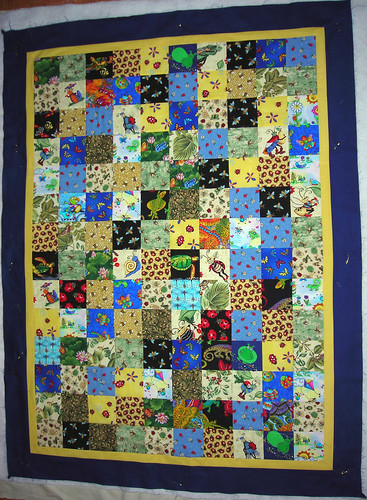 A long discourse on femininity in science. But first, let me show off my work.
A long discourse on femininity in science. But first, let me show off my work. Bug quilt! Courtesy of my favorite aunt's excellent quilt teaching. Also, notice the hippopotamuses (big green blotches). Indoctrinate 'em young! Bugs and animals are cool! For a dear friend who is not, at present, expecting a wee one.
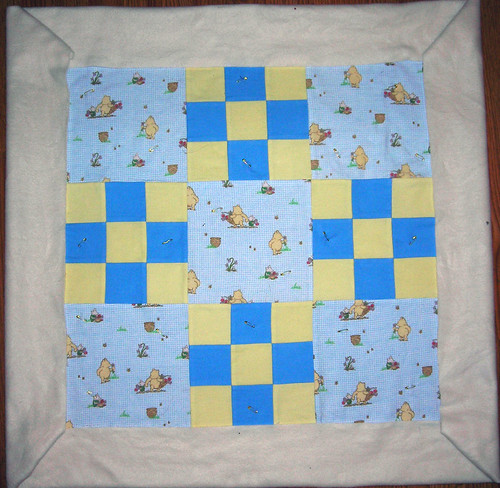 Pooh quilt! For my friend C, due in May, who is an artist of very definite opinions (though my mother says 'HAH! Raising a child is one long assault on your artistic sensibilities!'). Plus, the Pooh fabric was too cute for words.
Pooh quilt! For my friend C, due in May, who is an artist of very definite opinions (though my mother says 'HAH! Raising a child is one long assault on your artistic sensibilities!'). Plus, the Pooh fabric was too cute for words.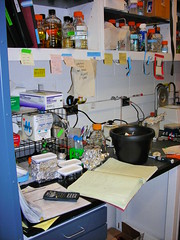 Thrilling lab bench. For contrast. That's right, I work amidst this chaos. I made all of those darn solutions. AND I know where everything is.
Thrilling lab bench. For contrast. That's right, I work amidst this chaos. I made all of those darn solutions. AND I know where everything is.I meet a lot of people who are amazed either a) that I can sew, bake eclairs, and apply makeup, because I'm a scientist or b) that I can do science research, hiking, and journal editing, because I look too girly.
I do have a point. I think this is part of a dangerous myth: Women scientist do not partake of the traditional feminine virtues because a) they are too busy being scientists or b) that identifies them with the Mom role or c) being a scientist places one outside the realm of traditional femininity and removes one from being a woman. Conversely, women who bake well cannot be good scientists. Maybe they spent too much time learning cookie recipes instead of injecting oocytes. ['Bake' here is: cooking, cleaning, sewing, childcare, laundry, mending, shopping...]
As it happens, I know how to do 'homemaker' things because my parents grew up poor. We're talking hunting squirrels for food, poor.* Among the 'upper classes' these are leisure activities, but in my family they are survival skills.
I would imagine this myth springs from the dominant old-white-guy paradigm: Old white guys are scientists; they do not bake; therefore scientists do not bake. Their wives and secretaries bake. Their wives stay home; their secretaries are subordinate. Therefore women who bake are not professional scientists. In my lab, I see mental binning going on all the time: girly girl or scientist? Wearing a pretty dress implies somehow that one cannot be serious. If one wishes to be taken seriously, one does not bring in cookies. One does not wear gauzy outfits, ribbons in one's hair, or pointy heels. Above all, one does not dress like a secretary (or like anyone else who doesn't have to worry about bleach, radiation, and coomassie blue). One wears jeans and a polo shirt every day, because that is the paradigm's uniform.
Speaking of this, a woman I know used to bring in cookies every week for her lab. And then - surprise!!- they treated her like a secretary, down to typing and proofreading. On a related note, there is a young woman in the next lab over who wears sweaters with pink bows on them. Shudder. However, her adviser is a sensible, egalitarian man who sends (male) postdocs with new babies home ('Take a month off! And get out of here!'). In fact, one day when I was gently telling this woman about all the kinds of discrimination I had personally experienced, she said 'My goodness, I had no idea. But it's not like that in my lab.' Well, lucky her. What happens when she goes to a conference?
I think this attitude of 'bows and cookies are incompatible with science' comes about because 1) there aren't that many female faculty; 2) statistically, female scientists less often have children or partners than do the male faculty; 3) women faculty have to be tough to survive;** 4) doing home-maker-y, unpaid-labor stuff is seen as weak, irrelevant, and unnecessary; 5) therefore they don't, in public. (Codicil: I doubt the women faculty like their colleagues enough to bake them cookies. Or have the time or energy. I don't. Either one.)
There is a certain necessity to 'act masculine' to get ahead: speak assertively, don't back down, argue, play dominance games. Being seen to do girly things ruins one's credibility in some strange way. There is a paradigm from centuries of straight men running the show. There is a stags-in-mating season paradigm. As someone else says, we all play at being some mean aggressive person. There is not yet, as far as I can tell, a strong female paradigm among [most] professional scientists. Women play tough to not get steamrollered, and baking cookies isn't tough.***
One day, there will be a world where it is okay, everywhere, to wear pink frilly things to lab. One day, young women will have strong female role models who will not fear the wrong pair of heels ruining their professional credos. There will be many professors and postdocs with kids. (I have had exactly one female mentor with children, and her baby was born nine months after tenure review, which is also known as buying into the system. Or at least: being afraid to go against the dominant paradigm, often with good reason.) One day, tenure will not depend on when you have your baby. That day is not now.
*Also, Grandpa Frank was a bootlegger because they could starve by selling it as corn, or eat by selling it as 'shine. And Great-Uncle Jughead ran sugar for the Mob. I am not making this up.
**And after hearing Titania's stories of the Bad Old Days, one can see why.
*** See also this, especially the paragraph that starts "In 16..." Why yes! Those are all the ways I've learned to be mean!
Tuesday, January 16, 2007
Absent-Mindedness Makes The Heart Grow Fonder
I lost my house keys. Panic! Disaster! Aaaah! I called: the library, the bus company, security, the police, two libraries, and the business office. I walked over two miles of pavement and three floors, peering into corners. No keys.
Mr. S and I shared a set. For a week. Oh, the inconvenience! The being locked out! So I called my poor landlord, who drove into town to sign the paper so the locksmith could make a key that he (the landlord) drove over to my apartment Sunday morning on his way to check the squirrel traps. Squirrels and dumb tenants: the banes of his existence.
I put the new key on a clip and got ready to leave the house. Mr. S said, Where are my keys, dear? In the dish by the back door. No, wait, they're here, dear. No, they're by the back door.
Huh?
Yes. In the key dish. Where they'd been all week.
I goes to gradewwute skool, I does.
Mr. S and I shared a set. For a week. Oh, the inconvenience! The being locked out! So I called my poor landlord, who drove into town to sign the paper so the locksmith could make a key that he (the landlord) drove over to my apartment Sunday morning on his way to check the squirrel traps. Squirrels and dumb tenants: the banes of his existence.
I put the new key on a clip and got ready to leave the house. Mr. S said, Where are my keys, dear? In the dish by the back door. No, wait, they're here, dear. No, they're by the back door.
Huh?
Yes. In the key dish. Where they'd been all week.
I goes to gradewwute skool, I does.
Monday, January 15, 2007
Ask A Scientist: Is Microwaving Plastic Wrap Bad? (2)
Part 1: Plastic Wrap and Dioxins
Part 2: Phthalates
[With correction below.]
2. Phthalates: In short, you may get small doses from microwaved plastics; but you’ll probably die of something else, eventually.
 Phthalates are known as ‘endocrine disruptors’, which means they can screw up your hormone system. Since hormones control everything from reproduction to disease response (inflammation and immune function), this can be very bad. Phthalates share a common structure (left), where ‘R’ is any chemical group, but usually a carbon chain or a benzene ring in this case. They are widely used as plasticizers, which in general impart some desired characteristic to the plastic by modifying the physical properties of the polymer base: flexibility, strength, color, etc. Many modern plastics have plasticizers in them; they have helped lift us out of the Bakelite era.
Phthalates are known as ‘endocrine disruptors’, which means they can screw up your hormone system. Since hormones control everything from reproduction to disease response (inflammation and immune function), this can be very bad. Phthalates share a common structure (left), where ‘R’ is any chemical group, but usually a carbon chain or a benzene ring in this case. They are widely used as plasticizers, which in general impart some desired characteristic to the plastic by modifying the physical properties of the polymer base: flexibility, strength, color, etc. Many modern plastics have plasticizers in them; they have helped lift us out of the Bakelite era.
 Phthalates in general bear a passing resemblance to estrogen (left: estradiol). DEHA (below left) is the phthalate most commonly worried about in plastic wrap. There is a whole group of these chemicals, with annoying names; mainly, the ones beginning with D have two ‘R’ groups, and the ones beginning with ‘M’ are usually metabolites of the D’s, in medical studies.
Phthalates in general bear a passing resemblance to estrogen (left: estradiol). DEHA (below left) is the phthalate most commonly worried about in plastic wrap. There is a whole group of these chemicals, with annoying names; mainly, the ones beginning with D have two ‘R’ groups, and the ones beginning with ‘M’ are usually metabolites of the D’s, in medical studies.
First the bad stuff: if you give a rat about 2.2 g/kg/day (1/500th of its body weight! For an average human, about five ounces a DAY) of butyl benzylphthalate.gif) phthalate, you get serious bad effects on the male reproductive system. Lower doses, 20 or 200 mg/kg/day, produce some mild anemia and small changes in blood cell distribution.
phthalate, you get serious bad effects on the male reproductive system. Lower doses, 20 or 200 mg/kg/day, produce some mild anemia and small changes in blood cell distribution.
A study by Swan et al. started much of the (scientific) fuss. The ‘ano-genital distance’, or AGD, which is what it sounds like, happens to differ inherently for male and female rats; same with humans, apparently. Swan and colleagues measured the AGD and a few other parameters (height, weight) and got urine samples out of 85/134 mothers. Then they did a bunch of fancy statistics.
Their conclusions are that 1) AGD is a measure of 'feminisation'; this is supported only by animal studies, and by AGD being different in male/ female humans and 2) phthalates are terribly, awfully dangerous because who knows what else could be happening; this is based on the assumption that AGD is an indicator of, well, anything.
There are many criticisms of this paper; I, for one, find it deeply unconvincing.
If you’re interested, look at Figure 1.They want to assert that there’s a large difference between the red dots and the blue dots. But they only have about ten kids each in the high/ low categories, so the data overlap a lot, plus the fit of AGI vs. age was messy to start with (R2=0.61, or 61% of the data can be explained by the fit). All their significant differences are between fit coefficients, not groups- that is, the data themselves when grouped don't have any real differences, but if you draw a 61%-accurate curve through the groups and compare the curves, you see a 'significant' difference.
Other people have criticized the phthalate testing in this study for not being normalized to sample volume (did the mothers drink a lot of water that morning?), for failing to take into account other factors that affect development, and for sampling wantonly across a broad age range. With such a small number, it is almost impossible to come up with true correlations in such complex processes. In other words: It’s like looking at a classroom and trying to figure out if the kids who are wearing Velcro sneakers are more likely to eat celery. You have no idea what else influences them, and you’re not entirely sure the two things are related, and you don’t have a big enough sample to tell anyways.
The authors claim that perhaps humans are very, very sensitive to phthalates: much more than rodents- and this accounts for lowering! sperm! counts! in men! worldwide crisis! Aaaaah! But the levels found in these human mothers are about 1 ug/kg/day ingested; that is, two hundred thousand (200,000) times less than the rats who had problems.
There is an excellent review on the possible effects of phthalates, and a summary of animal studies.
Overall, it seems like the levels of possible exposure from plastics are very low. In addition, Saran Wrap has no phthalates as plasticizers. It is likely that high exposures can cause fertility problems, and there are studies indicating that high levels can inhibit tamoxifen (i.e. screw up your breast cancer treatment, maybe). There is not good evidence that low levels will do any harm, and even if they do, your water is coming in PVC pipes; why are you worrying about the microwave? If it is a cancer risk, it is a low one; I imagine on par with eating well-grilled hamburger. There is no way to eliminate all risk.
So in brief:
The Canadian Conservation Institute cites several examples of commonly used polypropylene and styrene tubing that include plasticizers, as well.
[Note: I am not a medical professional; this should not substitute for medical advice or treatment. This is intended as an academic summary of the evidence available. For medical needs, please consult your physician.]
Part 2: Phthalates
[With correction below.]
2. Phthalates: In short, you may get small doses from microwaved plastics; but you’ll probably die of something else, eventually.
 Phthalates are known as ‘endocrine disruptors’, which means they can screw up your hormone system. Since hormones control everything from reproduction to disease response (inflammation and immune function), this can be very bad. Phthalates share a common structure (left), where ‘R’ is any chemical group, but usually a carbon chain or a benzene ring in this case. They are widely used as plasticizers, which in general impart some desired characteristic to the plastic by modifying the physical properties of the polymer base: flexibility, strength, color, etc. Many modern plastics have plasticizers in them; they have helped lift us out of the Bakelite era.
Phthalates are known as ‘endocrine disruptors’, which means they can screw up your hormone system. Since hormones control everything from reproduction to disease response (inflammation and immune function), this can be very bad. Phthalates share a common structure (left), where ‘R’ is any chemical group, but usually a carbon chain or a benzene ring in this case. They are widely used as plasticizers, which in general impart some desired characteristic to the plastic by modifying the physical properties of the polymer base: flexibility, strength, color, etc. Many modern plastics have plasticizers in them; they have helped lift us out of the Bakelite era. Phthalates in general bear a passing resemblance to estrogen (left: estradiol). DEHA (below left) is the phthalate most commonly worried about in plastic wrap. There is a whole group of these chemicals, with annoying names; mainly, the ones beginning with D have two ‘R’ groups, and the ones beginning with ‘M’ are usually metabolites of the D’s, in medical studies.
Phthalates in general bear a passing resemblance to estrogen (left: estradiol). DEHA (below left) is the phthalate most commonly worried about in plastic wrap. There is a whole group of these chemicals, with annoying names; mainly, the ones beginning with D have two ‘R’ groups, and the ones beginning with ‘M’ are usually metabolites of the D’s, in medical studies.First the bad stuff: if you give a rat about 2.2 g/kg/day (1/500th of its body weight! For an average human, about five ounces a DAY) of butyl benzyl
phthalate.gif) phthalate, you get serious bad effects on the male reproductive system. Lower doses, 20 or 200 mg/kg/day, produce some mild anemia and small changes in blood cell distribution.
phthalate, you get serious bad effects on the male reproductive system. Lower doses, 20 or 200 mg/kg/day, produce some mild anemia and small changes in blood cell distribution.A study by Swan et al. started much of the (scientific) fuss. The ‘ano-genital distance’, or AGD, which is what it sounds like, happens to differ inherently for male and female rats; same with humans, apparently. Swan and colleagues measured the AGD and a few other parameters (height, weight) and got urine samples out of 85/134 mothers. Then they did a bunch of fancy statistics.
Their conclusions are that 1) AGD is a measure of 'feminisation'; this is supported only by animal studies, and by AGD being different in male/ female humans and 2) phthalates are terribly, awfully dangerous because who knows what else could be happening; this is based on the assumption that AGD is an indicator of, well, anything.
There are many criticisms of this paper; I, for one, find it deeply unconvincing.
If you’re interested, look at Figure 1.They want to assert that there’s a large difference between the red dots and the blue dots. But they only have about ten kids each in the high/ low categories, so the data overlap a lot, plus the fit of AGI vs. age was messy to start with (R2=0.61, or 61% of the data can be explained by the fit). All their significant differences are between fit coefficients, not groups- that is, the data themselves when grouped don't have any real differences, but if you draw a 61%-accurate curve through the groups and compare the curves, you see a 'significant' difference.
Other people have criticized the phthalate testing in this study for not being normalized to sample volume (did the mothers drink a lot of water that morning?), for failing to take into account other factors that affect development, and for sampling wantonly across a broad age range. With such a small number, it is almost impossible to come up with true correlations in such complex processes. In other words: It’s like looking at a classroom and trying to figure out if the kids who are wearing Velcro sneakers are more likely to eat celery. You have no idea what else influences them, and you’re not entirely sure the two things are related, and you don’t have a big enough sample to tell anyways.
The authors claim that perhaps humans are very, very sensitive to phthalates: much more than rodents- and this accounts for lowering! sperm! counts! in men! worldwide crisis! Aaaaah! But the levels found in these human mothers are about 1 ug/kg/day ingested; that is, two hundred thousand (200,000) times less than the rats who had problems.
There is an excellent review on the possible effects of phthalates, and a summary of animal studies.
Overall, it seems like the levels of possible exposure from plastics are very low. In addition, Saran Wrap has no phthalates as plasticizers. It is likely that high exposures can cause fertility problems, and there are studies indicating that high levels can inhibit tamoxifen (i.e. screw up your breast cancer treatment, maybe). There is not good evidence that low levels will do any harm, and even if they do, your water is coming in PVC pipes; why are you worrying about the microwave? If it is a cancer risk, it is a low one; I imagine on par with eating well-grilled hamburger. There is no way to eliminate all risk.
So in brief:
- There may be some phthalate exposure from microwaving plastic.
- Everything else plastic in the world has phthalates in it. All your food has probably touched phthalates.
- Phthalates may or may not be harmful in food-plastic-related doses.
- Overall lifetime risk of cancer is high from all causes, because cancer is a disease of age. You have to die of something eventually. Have another hamburger.
- If you are really concerned about plasticizers leaking into your food: put new plastic containers in hot water with soap and soak overnight. This will probably remove whatever is water-soluble. Repeat with oil if you're feeling fanatical.
- If you’re really really worried about it, use glass, ceramic, and metal to replace all plastic containers in your life. But this will probably reduce your total exposure minimally.
The most frequently plasticized polymers include PVC, poly(vinyl butyral) or PVB, poly(vinyl acetate) or PVA, acrylics, cellulose molding compounds, nylon, polyamides and certain copolyamides. On average, PVC accounts for about 80% of all plasticizers consumed [11] (88% in Europe and 85% in North America [2]).Polystyrenes are sometimes plasticized for uses as yet unknown to me; also in fire-fighting gear.
The Canadian Conservation Institute cites several examples of commonly used polypropylene and styrene tubing that include plasticizers, as well.
[Note: I am not a medical professional; this should not substitute for medical advice or treatment. This is intended as an academic summary of the evidence available. For medical needs, please consult your physician.]
Friday, January 12, 2007
Friday Library: Science of Cooking, 2
Belle Lowe, Experimental Cookery
1st edition, 1932; Wiley
First part: Emulsions.
Wheat Flour and Bread
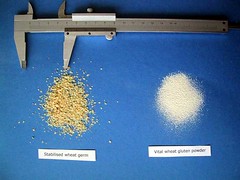 The protein particles in the flour may be compared to chewing gum, for many of the properties are similar... The behavior of the protein particles when moistened is similar to that of the gum. When first moistened they are crumbly and do not adhere together. After the particles become hydrated they become sticky and tenacious.
The protein particles in the flour may be compared to chewing gum, for many of the properties are similar... The behavior of the protein particles when moistened is similar to that of the gum. When first moistened they are crumbly and do not adhere together. After the particles become hydrated they become sticky and tenacious.
 Gluten forms a continuous phase in dough. The protein in the dough forms a continuous network or mesh structure throughout the dough. In this meshwork are the starch granules, the sugar, salts, and water.
Gluten forms a continuous phase in dough. The protein in the dough forms a continuous network or mesh structure throughout the dough. In this meshwork are the starch granules, the sugar, salts, and water.
The protein particles compose only a portion of the flour content, although after they are hydrated the relative volume that they occupy in the dough is greater than their volume in the flour. If to the chewing gum we add some small round particles… [they] will tend to keep the pieces of gum apart, so that manipulation and sliding over the round particles is required to bring different surfaces of the gum in contact with each other.
 ...A good quality of gluten must be elastic enough to stretch around the starch granules, and in addition stretch and retain gas bubbles formed in the dough that make the structure porous. No dough will retain all the gas formed within it, but a gluten of good quality will retain a very large portion of the gas bubbles.... Strong glutens may be improved by the addition of malt extract, which contains a larger proportion of the proteolytic enzyme protease than is found in the flour. Since part of the protein is hydrolyzed by the protease there is not such a compact mass left and the remaining gluten is softer and more elastic.
...A good quality of gluten must be elastic enough to stretch around the starch granules, and in addition stretch and retain gas bubbles formed in the dough that make the structure porous. No dough will retain all the gas formed within it, but a gluten of good quality will retain a very large portion of the gas bubbles.... Strong glutens may be improved by the addition of malt extract, which contains a larger proportion of the proteolytic enzyme protease than is found in the flour. Since part of the protein is hydrolyzed by the protease there is not such a compact mass left and the remaining gluten is softer and more elastic.
Bread.
Effect of mechanical treatment on extensibility of dough. Bailey and Le Vesconte have reported that prolonged mixing may destroy the cohesiveness of the gluten... The most extended experiments on the mechanical modification of gluten quality that have been reported are those of Swanson and Working. They devised a machine with a ‘pack-squeeze-pull-tear fashion.’ By mixing the dough for a longer time in this bread mixer they found that the bread could be baked at the end of the first fermentation period, thus decidedly shortening the total time for fermentation... ‘The figures for volume, color and texture show a progressive improvement with the length of time of mixing.’ Dough mixed for 15 minutes produced a loaf better in every way than a loaf mixed for 3 minutes and then fermented in the usual way.... Swanson states that... dough must not be squeezed too hard when kneaded just before it is put into the pan... If kneaded too hard just before being put in the pan these [meshwork of gluten] filaments are packed together and as a result a thicker cell wall is produced.
... Applying these results it can be stated that the first mixing and kneading, when the gluten is developed, should be thorough, but may not need heavy pressure, and the second and third kneading should be done with light pressure and should not be continued for too long a period...
The bowl that the dough is allowed to rise in should have only a thin film of fat... Heavy greasing may produce streaks in the bread... Harrel found that bread baked in ungreased pans gave a better volume and oven spring than bread baked in greased pans.
The staling of bread. ... Even if moisture loss is prevented from a loaf of bread certain changes take place within the loaf which give it a flinty feel and a crumbly texture. These are due to changes occurring in the starch and protein of the bread. In baking, the bread reaches a high temperature, and upon cooling these two systems are not in equilibrium. The staling process is reversible, i.e., the stale bread when heated again to a high temperature acquires the characteristics of fresh bread....
If the bread is kept at a temperature of 60 C or above, and if moisture loss and condensation of water are prevented, the bread stays fresh indefinitely. [Ed: Though it will probably grow Gooey Things.] Thus staling is brought about by cooling of the bread.... at about 40 C [bread] becomes approximately half stale, at 30 C it becomes still more stale, and at 17 to 0 C it becomes totally stale. But although at 0 C bread stales quickly, more intense cold inhibits staling.
1st edition, 1932; Wiley
First part: Emulsions.
Wheat Flour and Bread
 The protein particles in the flour may be compared to chewing gum, for many of the properties are similar... The behavior of the protein particles when moistened is similar to that of the gum. When first moistened they are crumbly and do not adhere together. After the particles become hydrated they become sticky and tenacious.
The protein particles in the flour may be compared to chewing gum, for many of the properties are similar... The behavior of the protein particles when moistened is similar to that of the gum. When first moistened they are crumbly and do not adhere together. After the particles become hydrated they become sticky and tenacious. Gluten forms a continuous phase in dough. The protein in the dough forms a continuous network or mesh structure throughout the dough. In this meshwork are the starch granules, the sugar, salts, and water.
Gluten forms a continuous phase in dough. The protein in the dough forms a continuous network or mesh structure throughout the dough. In this meshwork are the starch granules, the sugar, salts, and water.The protein particles compose only a portion of the flour content, although after they are hydrated the relative volume that they occupy in the dough is greater than their volume in the flour. If to the chewing gum we add some small round particles… [they] will tend to keep the pieces of gum apart, so that manipulation and sliding over the round particles is required to bring different surfaces of the gum in contact with each other.
 ...A good quality of gluten must be elastic enough to stretch around the starch granules, and in addition stretch and retain gas bubbles formed in the dough that make the structure porous. No dough will retain all the gas formed within it, but a gluten of good quality will retain a very large portion of the gas bubbles.... Strong glutens may be improved by the addition of malt extract, which contains a larger proportion of the proteolytic enzyme protease than is found in the flour. Since part of the protein is hydrolyzed by the protease there is not such a compact mass left and the remaining gluten is softer and more elastic.
...A good quality of gluten must be elastic enough to stretch around the starch granules, and in addition stretch and retain gas bubbles formed in the dough that make the structure porous. No dough will retain all the gas formed within it, but a gluten of good quality will retain a very large portion of the gas bubbles.... Strong glutens may be improved by the addition of malt extract, which contains a larger proportion of the proteolytic enzyme protease than is found in the flour. Since part of the protein is hydrolyzed by the protease there is not such a compact mass left and the remaining gluten is softer and more elastic.Bread.
Effect of mechanical treatment on extensibility of dough. Bailey and Le Vesconte have reported that prolonged mixing may destroy the cohesiveness of the gluten... The most extended experiments on the mechanical modification of gluten quality that have been reported are those of Swanson and Working. They devised a machine with a ‘pack-squeeze-pull-tear fashion.’ By mixing the dough for a longer time in this bread mixer they found that the bread could be baked at the end of the first fermentation period, thus decidedly shortening the total time for fermentation... ‘The figures for volume, color and texture show a progressive improvement with the length of time of mixing.’ Dough mixed for 15 minutes produced a loaf better in every way than a loaf mixed for 3 minutes and then fermented in the usual way.... Swanson states that... dough must not be squeezed too hard when kneaded just before it is put into the pan... If kneaded too hard just before being put in the pan these [meshwork of gluten] filaments are packed together and as a result a thicker cell wall is produced.
... Applying these results it can be stated that the first mixing and kneading, when the gluten is developed, should be thorough, but may not need heavy pressure, and the second and third kneading should be done with light pressure and should not be continued for too long a period...
The bowl that the dough is allowed to rise in should have only a thin film of fat... Heavy greasing may produce streaks in the bread... Harrel found that bread baked in ungreased pans gave a better volume and oven spring than bread baked in greased pans.
The staling of bread. ... Even if moisture loss is prevented from a loaf of bread certain changes take place within the loaf which give it a flinty feel and a crumbly texture. These are due to changes occurring in the starch and protein of the bread. In baking, the bread reaches a high temperature, and upon cooling these two systems are not in equilibrium. The staling process is reversible, i.e., the stale bread when heated again to a high temperature acquires the characteristics of fresh bread....
If the bread is kept at a temperature of 60 C or above, and if moisture loss and condensation of water are prevented, the bread stays fresh indefinitely. [Ed: Though it will probably grow Gooey Things.] Thus staling is brought about by cooling of the bread.... at about 40 C [bread] becomes approximately half stale, at 30 C it becomes still more stale, and at 17 to 0 C it becomes totally stale. But although at 0 C bread stales quickly, more intense cold inhibits staling.
Unpublished Letters of an Editor
Dear Author,
Dude, thanks for calling our long-suffering staff editor four (4) times from Brazil! According to our lame-o records, you sent us that manuscript two years ago. Are you up for tenure, or perhaps grant renewal? Normal humans would have a) withdrawn the MS long ago; b) called a year ago; or c) assumed the answer was NO. Which it is. Yo, if we're going to publish, we bloody well write.
Actually, why did you bother submitting it? It sucked. We don't care what happens when you label Chemical X and feed it to rats. It goes to the kidneys? YOU DON'T SAY.
In case you're still wondering, the answer is, rejected without review. Cheers!
Sincerely yours,
Annoyed Editor
P.S. We deeply (okay, maybe not so deeply) regret the delay. Our whole staff quit one day last March. We can't even find our subscriber list! You're lucky we remember who you are! Sorry!
Dude, thanks for calling our long-suffering staff editor four (4) times from Brazil! According to our lame-o records, you sent us that manuscript two years ago. Are you up for tenure, or perhaps grant renewal? Normal humans would have a) withdrawn the MS long ago; b) called a year ago; or c) assumed the answer was NO. Which it is. Yo, if we're going to publish, we bloody well write.
Actually, why did you bother submitting it? It sucked. We don't care what happens when you label Chemical X and feed it to rats. It goes to the kidneys? YOU DON'T SAY.
In case you're still wondering, the answer is, rejected without review. Cheers!
Sincerely yours,
Annoyed Editor
P.S. We deeply (okay, maybe not so deeply) regret the delay. Our whole staff quit one day last March. We can't even find our subscriber list! You're lucky we remember who you are! Sorry!
Thursday, January 11, 2007
Ask A Scientist: Is Microwaving Plastic Wrap Bad?
A Gentle Reader asks: "Will you take blog suggestions and answer science questions?" Of course! Any time, dear readers; I regard it as my sacred calling to spread the word of science understanding. So, the first question:
"What exactly is the risk to one's health of microwaving food with saran wrap on top?
There are two things most often cited as health risks of heating plastic: dioxin(s) and phthalates. Here's my scientific summary: dioxins are not in plastic and are not formed in the microwave. Phthalates are present in many plastics; they have no demonstrated effect at low levels. There are proven effects in rats, but at higher levels than we eat. The risk appears to be low, as in less than getting run over by a truck. If you're really worried about it, use a paper towel or paper plate or wax paper on top of your food in the microwave. Actually, use wax paper anyways: it decomposes.
1. Dioxin: In short, don’t worry about it (in your plastic wrap).
 Dioxin describes a class of chemicals made of two benzene rings connected by two oxygens. They are often halogenated (that is, they contain chlorine or fluorine) and the chemical TCDD is commonly referred to as ‘dioxin’.
Dioxin describes a class of chemicals made of two benzene rings connected by two oxygens. They are often halogenated (that is, they contain chlorine or fluorine) and the chemical TCDD is commonly referred to as ‘dioxin’.
Dioxin is in fact very bad for you; it was a contaminant in Agent Orange, causing thousands of
SC Johnson informs us that their products have no chlorine or dioxin. But do they form dioxin during cooking??? you ask. No. Monochlorinated dioxin is formed ‘as low as 400 C’ in a chemical study; an old CNN article cites a minimum of 300 C in the presence of metallic catalysts (during trash burning) for dioxin formation.
The EPA told us (2000 data) that the greatest atmospheric dioxin levels come, in fact, from backyard burning. The FDA also informs us that “although dioxin is an environmental contaminant, most dioxin exposure occurs through the diet, with over 95% coming through dietary intake of animal fats”. Since dioxin is stored in fat, it bioaccumulates up the food chain; age and fat/meat consumption are strong predictors of total body dioxin levels.
So in brief:
Monday: Part 2, Phthalates
[Note: I am not a medical professional; this should not substitute for medical advice or treatment. This is intended as an academic summary of the evidence available. For medical needs, please consult your physician.]
"What exactly is the risk to one's health of microwaving food with saran wrap on top?
There are two things most often cited as health risks of heating plastic: dioxin(s) and phthalates. Here's my scientific summary: dioxins are not in plastic and are not formed in the microwave. Phthalates are present in many plastics; they have no demonstrated effect at low levels. There are proven effects in rats, but at higher levels than we eat. The risk appears to be low, as in less than getting run over by a truck. If you're really worried about it, use a paper towel or paper plate or wax paper on top of your food in the microwave. Actually, use wax paper anyways: it decomposes.
1. Dioxin: In short, don’t worry about it (in your plastic wrap).
 Dioxin describes a class of chemicals made of two benzene rings connected by two oxygens. They are often halogenated (that is, they contain chlorine or fluorine) and the chemical TCDD is commonly referred to as ‘dioxin’.
Dioxin describes a class of chemicals made of two benzene rings connected by two oxygens. They are often halogenated (that is, they contain chlorine or fluorine) and the chemical TCDD is commonly referred to as ‘dioxin’.Dioxin is in fact very bad for you; it was a contaminant in Agent Orange, causing thousands of
SC Johnson informs us that their products have no chlorine or dioxin. But do they form dioxin during cooking??? you ask. No. Monochlorinated dioxin is formed ‘as low as 400 C’ in a chemical study; an old CNN article cites a minimum of 300 C in the presence of metallic catalysts (during trash burning) for dioxin formation.
The EPA told us (2000 data) that the greatest atmospheric dioxin levels come, in fact, from backyard burning. The FDA also informs us that “although dioxin is an environmental contaminant, most dioxin exposure occurs through the diet, with over 95% coming through dietary intake of animal fats”. Since dioxin is stored in fat, it bioaccumulates up the food chain; age and fat/meat consumption are strong predictors of total body dioxin levels.
So in brief:
- There is no dioxin in Saran wrap, and likely not in other brands.
- Dioxin will not form in a microwave, unless it is on fire.
- If you’re really worried about dioxin, avoid Russian spies and become a vegetarian.
Monday: Part 2, Phthalates
[Note: I am not a medical professional; this should not substitute for medical advice or treatment. This is intended as an academic summary of the evidence available. For medical needs, please consult your physician.]
Wednesday, January 10, 2007
Where All The Women Are Strong
A professorial friend meets with the department chair for the annual raking over the coals.
-Well, I'm just not sure the numbers for your course evaluations are high enough. You know, they're good, but we'd like to see higher.
-Okay, why?
-We want all the professors in our department to be above average!
-[Hah, ha ha ha... oh, he's serious.]
The friend is now formerly professorial, and very much happier thereby.
In related news, tomorrow I get to be similarly raked by my advisor. It's the highlight of my year, let me tell you. What do I want to accomplish by June? To graduate. Ha ha ha.
-Well, I'm just not sure the numbers for your course evaluations are high enough. You know, they're good, but we'd like to see higher.
-Okay, why?
-We want all the professors in our department to be above average!
-[Hah, ha ha ha... oh, he's serious.]
The friend is now formerly professorial, and very much happier thereby.
In related news, tomorrow I get to be similarly raked by my advisor. It's the highlight of my year, let me tell you. What do I want to accomplish by June? To graduate. Ha ha ha.
Tuesday, January 09, 2007
Department of Random Outrage, 2
Also behold:

A salt lamp that “possess[es] the unique capability of generating negative ions in the air thus working as [an] ionizer. These negative ions are very essential for human beings because they purify the air, and kill bacteria and other harmful organisms and increase overall air quality.”
Magic Salt Lamp. As in, made of table salt, Na(+)Cl(-). Where are these negative ions supposed to come from? If from the salt, NaCl must be heated to 2575°F before it boils. Decomposition temperature- the heat necessary to make it break down into separate ions of Na(+) and Cl(-) - is much higher. And you’d get both anions and cations; both are very reactive. Chlorine anions may form ozone or chlorine gas; Cl2 gas is very poisonous. Sodium metal, whether ionized or not, is extremely reactive; the metallic form is prone to exploding, as we all remember from high school chemistry demos.
It is possible to ionize air using high voltage; this is what many commercial air ionizers do. But according to JPL , they must be calibrated regularly to ensure they continue to be negative ion sources. Polonium is also used; radioactive ionizers must be replaced yearly because of polonium's short half-life. (The manufacturer assures us that the capsules are very well sealed, to prevent anyone removing the polonium.)
A naked wire may indeed ionize air; this is part of why lightbulbs are evacuated- otherwise the wire would oxidize and burn out. UV light also ionizes air; many air purifiers are based on this, plus charged plates to remove the now-ionized dust and such. In any case, a sealed lightbulb won’t do it.
[By the way, I have no financial or other interest in any of the products or sites mentioned, nor indeed in any product or site. Links are provided solely for reference and entertainment.]

A salt lamp that “possess[es] the unique capability of generating negative ions in the air thus working as [an] ionizer. These negative ions are very essential for human beings because they purify the air, and kill bacteria and other harmful organisms and increase overall air quality.”
Magic Salt Lamp. As in, made of table salt, Na(+)Cl(-). Where are these negative ions supposed to come from? If from the salt, NaCl must be heated to 2575°F before it boils. Decomposition temperature- the heat necessary to make it break down into separate ions of Na(+) and Cl(-) - is much higher. And you’d get both anions and cations; both are very reactive. Chlorine anions may form ozone or chlorine gas; Cl2 gas is very poisonous. Sodium metal, whether ionized or not, is extremely reactive; the metallic form is prone to exploding, as we all remember from high school chemistry demos.
It is possible to ionize air using high voltage; this is what many commercial air ionizers do. But according to JPL , they must be calibrated regularly to ensure they continue to be negative ion sources. Polonium is also used; radioactive ionizers must be replaced yearly because of polonium's short half-life. (The manufacturer assures us that the capsules are very well sealed, to prevent anyone removing the polonium.)
A naked wire may indeed ionize air; this is part of why lightbulbs are evacuated- otherwise the wire would oxidize and burn out. UV light also ionizes air; many air purifiers are based on this, plus charged plates to remove the now-ionized dust and such. In any case, a sealed lightbulb won’t do it.
[By the way, I have no financial or other interest in any of the products or sites mentioned, nor indeed in any product or site. Links are provided solely for reference and entertainment.]
Monday, January 08, 2007
Bureaucratic Logic
Mr. S goes to the DMV to renew his license.
-You have to show proof of Social Security number.
-I don't have any with me.
-Then go to the Social Security office.
-. . . Er?
-If you show your driver's license they'll give you a new Social Security card.
-Of course.
Brought to you by the Real ID act! Motto: Here to Confuse and Impede! (Also: No asylum for terror. Terrorists. Whatever.)
I'd like to note that in the original incarnation of the act, asylum-seekers would have been required to obtain written evidence that they had in fact been persecuted. From the government that had persecuted them. "Yes, we did beat and torture Mr. Bamba! Thanks for asking!"
As I've mentioned, I translate for asylum candidates. As in this article, one of our clients was initially denied for not being 'credible': the client could not remember every detail of their rape and beating.
And it clearly makes driver's licenses safe against terror. Yep.
[Real ID on glin.gov: 119 stat. 303, p.73]
-You have to show proof of Social Security number.
-I don't have any with me.
-Then go to the Social Security office.
-. . . Er?
-If you show your driver's license they'll give you a new Social Security card.
-Of course.
Brought to you by the Real ID act! Motto: Here to Confuse and Impede! (Also: No asylum for terror. Terrorists. Whatever.)
I'd like to note that in the original incarnation of the act, asylum-seekers would have been required to obtain written evidence that they had in fact been persecuted. From the government that had persecuted them. "Yes, we did beat and torture Mr. Bamba! Thanks for asking!"
As I've mentioned, I translate for asylum candidates. As in this article, one of our clients was initially denied for not being 'credible': the client could not remember every detail of their rape and beating.
And it clearly makes driver's licenses safe against terror. Yep.
[Real ID on glin.gov: 119 stat. 303, p.73]
Friday, January 05, 2007
Friday Library: Science of Cooking
Belle Lowe, Experimental Cookery
1st edition, 1932; Wiley
This remarkable scientist was born in 1886; she became a professor just after World War I ended, and worked until five years before her death. Her textbook, “Experimental Cookery: From the Chemical and Physical Standpoint (With a Laboratory Outline)” is certainly the intellectual precursor of better-known books such as McGee’s “On Food and Cooking”.
This is a perfect example, to me, of a smart female scientist being denied access to ‘real’ science, and turning to an acceptably feminine branch instead. The book is incredibly well-researched and referenced; the meticulous experimental protocols leave me yearning to test exactly what effect stirring time does have on muffin shape. She devoted her life to working out the best scientific conditions for cooking, with precision, accuracy, and detail.
Emulsions
Bancroft states that the necessary conditions for forming a stable emulsion are that the drops of the dispersed phase shall be so small that they will stay suspended and that there shall be a sufficiently viscous film around each drop to keep the drops of the dispersed phase from coalescing... Fischer and Hooker state that hydrated colloids make the best emusifiers. For the formation of a stable emulsion the colloid must absorb or bind all the water... The hydration theory... seems to be most applicable to emulsions like cream puffs, in which the emulsion is subjected to heat during cooking, and the presence of too small a quantity of water causes breaking of the emulsion.
…
Seifriz, in his work with petroleum oil emulsions stabilized with casein solution [a milk protein], found that the oils with a specific gravity of 0.828 or below form oil-in-water emulsions… [he] concludes that ‘the chemical interaction of oil, stabilizer, and electrolytes determines the behavior of emulsions, and… is likely to differ if one of the three factors is changed.’
[Mayonnaise]
With egg yolk all the oils and fats [butter, lard, Crisco, Snowdrift; cottonseed, corn, olive, and peanut oils] gave a very stable emulsion of the oil-in-water type. With egg white as the emulsifier, oil forms an oil-in-water emulsion… When the oil is added gradually to the egg white, a foam as well as an emulsion is formed… The illustration also shows that the oil is adsorbed in the film or layer at the interface between a liquid and a gas.
…
With a saturated casein solution as the emulsifier, the water-in-oil type of emulsion predominates when butter, lard, Crisco, and oil are used. The emulsions are rather coarse and unstable. With milk as the emulsifier no permanent emulsion has been obtained with corn or cottonseed oil… When allowed to cool so that the fat solidifies, the emulsions made with fat remain permanent, until stirred. When stirred after the fat has hardened the water collects in large drops, and is similar to collecting of water when butter is worked.
Factors Affecting the Formation of Emulsion in Mayonnaise
(1) The kind of bowl and beating utensil used. (2) The method of mixing. (3) The quantity of oil that is added at first. (4) The kind of oil used. (5) The method of adding the vinegar. (6) The amount of salt, spices, and vinegar used. (7) Use of fresh or storage eggs. (8) The addition of a small amount of emulsified mayonnaise. (9) Temperature.
[highlights]
-Microscopic examination of mayonnaise made by intermittent and continuous mixing shows little difference in the size of the oil particles and the stability of the emulsion.
-Mayonnaise is formed more readily if the quantity of oil added at first is small. Robinson states that, if the oil is added too rapidly… the oil phase may unite, and breaking of the emulsion occurs.
-The following amounts of oil could be emulsified in 15.5 grams of egg yolk:
Pure Italian olive oil.......296 grams
California olive oil..........344 grams
Mazola..............................399 grams
Wesson’s oil....................432 grams
-However, the size of the oil particles that are first emulsified is quite large when the vinegar is added to the egg yolk before ht eoil is added. But with each subsequent addition of oil the dispersed particles become smaller, and the mayonnaise stiffer.
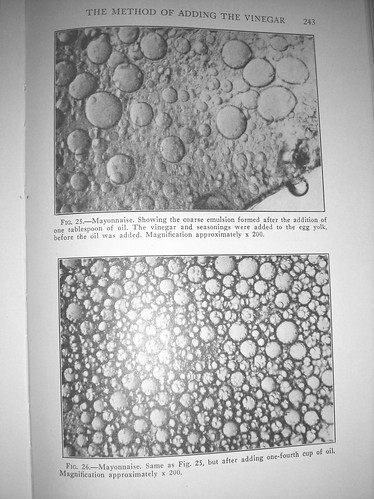
-When the salt is added to the mayonnaise after the oil has been added, the size of the dispersed oil globules is larger and the emulsion breaks more readily...
-Egg yolk, whole egg, egg white, cooked egg yolk, gelatin, and starch pastes may be used for the emulsifying agent in making mayonnaise, if an oil and not a fat is used for the dispersed phase. However, they are not equally efficient. Microscopic examination shows that egg yolk emulsions have the smallest oil globules, gelatin and cornstarch paste the largest...Meat extract and some other materials may be used for emulsifiers, but most of them are not so satisfactory as the egg yolk.
1st edition, 1932; Wiley
This remarkable scientist was born in 1886; she became a professor just after World War I ended, and worked until five years before her death. Her textbook, “Experimental Cookery: From the Chemical and Physical Standpoint (With a Laboratory Outline)” is certainly the intellectual precursor of better-known books such as McGee’s “On Food and Cooking”.
This is a perfect example, to me, of a smart female scientist being denied access to ‘real’ science, and turning to an acceptably feminine branch instead. The book is incredibly well-researched and referenced; the meticulous experimental protocols leave me yearning to test exactly what effect stirring time does have on muffin shape. She devoted her life to working out the best scientific conditions for cooking, with precision, accuracy, and detail.
Emulsions
Bancroft states that the necessary conditions for forming a stable emulsion are that the drops of the dispersed phase shall be so small that they will stay suspended and that there shall be a sufficiently viscous film around each drop to keep the drops of the dispersed phase from coalescing... Fischer and Hooker state that hydrated colloids make the best emusifiers. For the formation of a stable emulsion the colloid must absorb or bind all the water... The hydration theory... seems to be most applicable to emulsions like cream puffs, in which the emulsion is subjected to heat during cooking, and the presence of too small a quantity of water causes breaking of the emulsion.
…
Seifriz, in his work with petroleum oil emulsions stabilized with casein solution [a milk protein], found that the oils with a specific gravity of 0.828 or below form oil-in-water emulsions… [he] concludes that ‘the chemical interaction of oil, stabilizer, and electrolytes determines the behavior of emulsions, and… is likely to differ if one of the three factors is changed.’
[Mayonnaise]
With egg yolk all the oils and fats [butter, lard, Crisco, Snowdrift; cottonseed, corn, olive, and peanut oils] gave a very stable emulsion of the oil-in-water type. With egg white as the emulsifier, oil forms an oil-in-water emulsion… When the oil is added gradually to the egg white, a foam as well as an emulsion is formed… The illustration also shows that the oil is adsorbed in the film or layer at the interface between a liquid and a gas.
…
With a saturated casein solution as the emulsifier, the water-in-oil type of emulsion predominates when butter, lard, Crisco, and oil are used. The emulsions are rather coarse and unstable. With milk as the emulsifier no permanent emulsion has been obtained with corn or cottonseed oil… When allowed to cool so that the fat solidifies, the emulsions made with fat remain permanent, until stirred. When stirred after the fat has hardened the water collects in large drops, and is similar to collecting of water when butter is worked.
Factors Affecting the Formation of Emulsion in Mayonnaise
(1) The kind of bowl and beating utensil used. (2) The method of mixing. (3) The quantity of oil that is added at first. (4) The kind of oil used. (5) The method of adding the vinegar. (6) The amount of salt, spices, and vinegar used. (7) Use of fresh or storage eggs. (8) The addition of a small amount of emulsified mayonnaise. (9) Temperature.
[highlights]
-Microscopic examination of mayonnaise made by intermittent and continuous mixing shows little difference in the size of the oil particles and the stability of the emulsion.
-Mayonnaise is formed more readily if the quantity of oil added at first is small. Robinson states that, if the oil is added too rapidly… the oil phase may unite, and breaking of the emulsion occurs.
-The following amounts of oil could be emulsified in 15.5 grams of egg yolk:
Pure Italian olive oil.......296 grams
California olive oil..........344 grams
Mazola..............................399 grams
Wesson’s oil....................432 grams
-However, the size of the oil particles that are first emulsified is quite large when the vinegar is added to the egg yolk before ht eoil is added. But with each subsequent addition of oil the dispersed particles become smaller, and the mayonnaise stiffer.

-When the salt is added to the mayonnaise after the oil has been added, the size of the dispersed oil globules is larger and the emulsion breaks more readily...
-Egg yolk, whole egg, egg white, cooked egg yolk, gelatin, and starch pastes may be used for the emulsifying agent in making mayonnaise, if an oil and not a fat is used for the dispersed phase. However, they are not equally efficient. Microscopic examination shows that egg yolk emulsions have the smallest oil globules, gelatin and cornstarch paste the largest...Meat extract and some other materials may be used for emulsifiers, but most of them are not so satisfactory as the egg yolk.
Thursday, January 04, 2007
Christmas Pictures!
Wednesday, January 03, 2007
Department of Random Outrage
 Behold:
Behold:A dog blanket that, and I quote, has “Anion, Aloe, Anti-bacteria and Magnet complex functions” and “emit[s] Far Infrared Rays”.
I understand that people want cures, and are willing to suspend disbelief. But must they also suspend logic? Does anyone actually buy this stuff?
Magic Dog Blanket. I’ll believe it has aloe in it, and antibacterial fabric exists. But I bet you a dollar that any sterile dog is going right into surgery. Dogs, they roll in dead things. Additionally, no animal is ever truly sterile- there are always bacteria on the skin, in the gut, and in the mouth; alterations in natural flora can have bad consequences.
The blanket may even have magnets sewn into it. (You know, to align all the little iron particles in your cells.) But magnets don't do anything for circulation or pain. The greatest effect of magnetized fabric will be to erase the credit cards if Muffy gets close enough to your wallet- though only if it's a fairly strong magnet.
Far-IR rays are another thing altogether. Shorter IR wavelengths are what make you warm in the sun, and longer wavelengths (i.e., past far-IR) are what your microwave makes. But ceramic doesn’t just emit 'IR rays' [any more than anything else does at room temperature]. IR, just like a light bulb or an x-ray or every other part of the electromagnetic spectrum, is made of energy. Electricity goes into a microwave, is converted to IR, and is then converted to motion in the water molecules, which we call 'heat.' Energy input is required to sustain continuous [over-background] IR output.
This is also why microwaves have to be plugged in.
[Correction courtesy of Andre: I failed to specify that all materials emit some in the IR, as well as in other frequencies, at room temperature. See also: blackbody radiation in IR occurs between 30 and 4100 K.]
Tuesday, January 02, 2007
Highs and Lows
Having been thoroughly traumatized- though less than last year!- I have returned to the wilds of Snootyville. I have some lovely pictures to share. Once I remember the cable.
Lows:
We shall return shortly to our regularly scheduled outrage and scientific randomness.
Lows:
- We should ship all them dem Mexicans off to Iyrack. Then our good Amurrican soldiers won’ have to die.
- Well, it’s just a man’s place to fight for his country. Women should take care of the babies.
- There’s no prejudice against women in the military. They get preference! There’s quotas!
- [Baking strawberry shortbread] is a woman’s job.
- I, um, had a thing with little Catherine [redacted]. [Ew.]
- Digital camera! Much better than another neon pink cardigan.
- Favorite aunt and uncle, six cousinettes, a Vietnamese restaurant, and a bottle of wine!
- Quilt top for… er, maybe NOT for Fluffhead.
- Brilliant book from 1932 on the chemistry of cooking. Back in the day when women could only teach in the home ec department! 300 pages of chemical analysis of angel food cake, lard, and meringue, i.e. great frustration channeled through the kitchen.
We shall return shortly to our regularly scheduled outrage and scientific randomness.
Subscribe to:
Comments (Atom)



